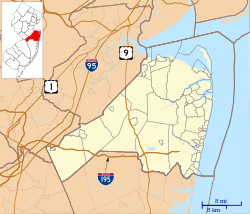Palace Amusements

Palace Amusements in 1997
|
|
| Location | Asbury Park, NJ |
|---|---|
| Theme | Indoor amusement park |
| Owner | Ernest Schnitzler (1888-1920s) August Williams (1920s-1939) Edward Lange & Zimel Resnick (1940s-1986) Sam & Henry Vaccaro (1986-1988) |
| Opened | July 4, 1888 |
| Closed | November 27, 1988 |
| Previous names | Palace Merry-Go-Round |
| Area | 0.9 acres (0.36 ha) |
| Rides | |
| Total | 12 |
| Roller coasters | 1 |
| Water rides | 1 |
| Status | Closed/Demolished |
| Location | Asbury Park, New Jersey |
|---|---|
| Coordinates | 40°13′4″N 74°0′12.76″W / 40.21778°N 74.0035444°WCoordinates: 40°13′4″N 74°0′12.76″W / 40.21778°N 74.0035444°W |
| Built | June 1888 |
| Built by | Ernest Schnitzler |
| Architect | Ernest Schnitzler William B. Stout |
| Architectural style | Late Victorian |
| Demolished | May 26, 2004 |
| NRHP Reference # | 00001406 |
| NJRHP # | 3705 |
| Significant dates | |
| Added to NRHP | November 22, 2000 |
| Designated NJRHP | October 12, 2000 |
Palace Amusements was a historical indoor amusement park in Asbury Park, New Jersey. Built in 1888, and expanded several times over its history, the 100-year-old structure saw the good and bad of the storied Asbury Park boardwalk, withstood multiple nor'easters and hurricanes and both the Great Depression and World War II. After several different owners and an increase in competition from other nearby attractions and worsening economic situation in both Asbury and the country in the mid-1980s, the park had to declare bankruptcy and closed its doors for good in 1988.
Several efforts were made to save the historic structure, including its hand-carved carousel and infamous murals and decorations, but in 2004, after an independent structural inspection, the building was deemed unsafe (and already damaged in several areas) and was ordered demolished. A local grassroots organization was able to save several pieces from the building, including the famed Tillie mural.
On February 20, 1888, Ernest S. Schnitzler, a well-established German immigrant who already had several interests in Atlantic City, set out to build a pleasure palace at the corner of Lake Avenue and Kingsley Street in Asbury Park, New Jersey. After placing ads in local directories promoting the new amusement attraction, a contract was created for local workmen to remove planks from a 100 by 190 feet (30 m × 58 m) skating rink – known as the Surf Palace – for reuse "as far as possible" in the construction of the new building. Despite the arrival of a deadly nor'easter on March 12, which dumped up to an estimated 40 inches (1,000 mm) of snow from Maryland to Maine, it appeared as if nothing could discouraged Schnitzler from pursuing his dream. By June 1, the four-sided Victorian pavilion was nearly done. Asbury Park carpenter had built a 93 by 100 feet (28 m × 30 m) one-story structure and local roofer Joseph L. Seamon covered the double hip roof with 11,300 square feet (1,050 m2) of felt roofing. At ground level, wood frame doors with colored glass slid along horizontal rails, while higher up, a band of windows separated the lower and upper hip roofs. Inside, there were no partitions or finishes, leaving an exposed framing system. In a sense, it was big box.
Schnitzler's big box was for them, the men in top hats and the women with their parasols, the summer folk who rode the railroad from New York City and middle New Jersey to enjoy the mile-and-a-quarter stretch of oceanfront Asbury. They walked Bradley's boardwalk, took in performances in the orchestra pavilion, visited the public baths and strolled the pier at the south end of the boardwalk, but except for the roller toboggan at the southwest corner of Ocean and 2nd Avenues, there wasn't much by way of organized amusements. That was the niche Schnitzler intended to fill and he was soon placing advertisements in the city directory describing his pleasure palace as a place of "refined amusement for Ladies, Gents, and Children. Polite Attendants. First-Class Soda for sale in the Building." At the heart of his enterprise, as his premium draw, Schnitzler placed a great carousel crafted by Charles I.D. Looff, who was among the first eminent American carousel builders. The three-row machine held 70 hand carved animals, of slender and stylized bodies, spirited expressions and elaborate trappings. Most were carved by Looff, but under the pressure of a delivery deadline, a few were purchased from the master carver Gustav Dentzel of Philadelphia.
...
Wikipedia

